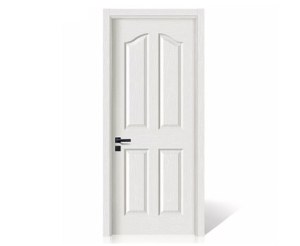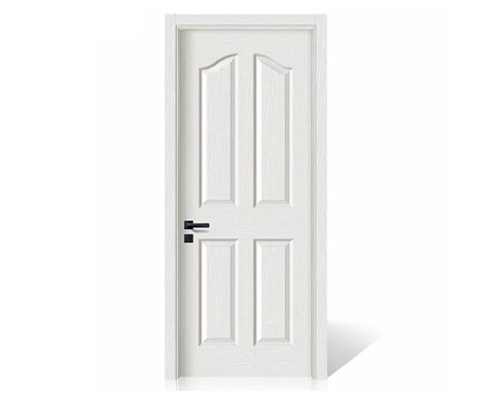Fire Rated Door
Fire resistant internal doors, also called fire protection door, provide around-the-clock protection to help ensure people can safely evacuate a building in the event of a fire. When they're not called upon to limit the spread of fire and provide safe egress, they serve as a regular door pathway, making good visibility crucial. As a professional China fire door factory , Simto's line of commercial fire-rated doors check both boxes, and more.
Fire Door VS Normal Door
China fire doors and normal doors differ in their ability to resist fire and smoke. Here are some of the key differences:
Fire resistance: Modern fire rated doors are designed to resist fire and smoke for a specific period of time, whereas normal doors are not. Fire doors are tested and rated according to how long they can withstand fire and smoke, usually 30, 60 or 90 minutes. Normal doors are not tested for fire resistance and may not provide any protection in the event of a fire.
Materials: Fire doors are made from special china fire door materials that are designed to be fire-resistant, such as steel, gypsum, or glass reinforced gypsum. Normal doors are typically made from wood or composite materials.
Seals: Fire doors are equipped with intumescent seals that expand when exposed to heat, helping to prevent the spread of fire and smoke. Normal doors do not have these seals and may allow smoke and fire to spread more easily.
Hardware: Fire doors must be equipped with appropriate hardware, such as fire-rated hinges and door closers, to ensure that they function correctly during a fire. Normal doors may not be equipped with this hardware and may not function properly during a fire.
Installation: Fire resistant front door must be installed by qualified modern doors company professionals in accordance with specific guidelines, to ensure that they are effective in preventing the spread of fire and smoke. Normal doors can be installed by anyone with basic DIY skills.
Overall, fire doors are a critical component of a building's fire protection system, and they play a crucial role in protecting people and property in the event of a fire. Normal doors do not provide the same level of protection and are not suitable for use in areas where fire resistance is required.
What Are Fire Doors Used for
Fire doors are used to prevent the spread of fire and smoke in a building, and to provide a safe means of escape in the event of a fire. They are typically installed in areas where the risk of fire is high, such as stairwells, corridors, and between different parts of a building. Here are some common uses of fire doors:
Fire exits: Fire rated external doors are often used as fire exits, providing a safe means of escape in the event of a fire. They are typically installed in stairwells and corridors, and are designed to resist fire and smoke for a specific period of time, usually 30, 60, or 90 minutes.
Compartmentalization: Fire doors are used to compartmentalize a building, which means dividing the building into separate areas that can be sealed off in the event of a fire. This helps to prevent the spread of fire and smoke from one area to another, giving occupants more time to evacuate and reducing the risk of damage to the building.
Hazardous areas: Fireproof exterior doors are often installed in areas that contain hazardous materials or equipment, such as chemical storage areas or boiler rooms. These doors help to contain any fires that may occur in these areas, preventing them from spreading to other parts of the building.
Building codes: Fire doors are required by building codes and regulations in many jurisdictions, particularly in commercial and public buildings. These codes specify the types of fire doors that must be installed, as well as their ratings and installation requirements.
Overall, similar to China security steel door, fire doors are an important component of a building's fire protection system, and they play a critical role in preventing the spread of fire and smoke, protecting occupants, and reducing damage to the building.
Fire Resistant Door Applications
A fire resistant door is a sealed door between compartments, meant to prevent or slow the spread of fire, smoke and heat between those compartments. While their use is usually required in commercial property, homeowners often install them in places where there is a bigger fire risk (such as in between your kitchen and the rest of your home). Fire retardant doors are generally fire-resistant sealed-frame doors, made of various materials and installed in fire-rated walls. Modern fire rated doors requirements are set by the National Fire Protection Association, and these requirements have been incorporated into most local building codes in the United States with little to no modification.
Fire Rated Door Features
1. Fire-Rated Door Construction: Fire-rated doors are typically constructed using solid wood, steel, or aluminum, and must meet the fire resistance ratings specified by building codes.
2. Fire-Rated Door Core: The core of a fire-rated door is typically made from a material such as gypsum board or mineral wool that is designed to resist high temperatures for a certain amount of time.
3. Fire-Rated Door Gaskets: China Fire-rated doors are typically equipped with a rubber gasket designed to create an airtight seal that prevents smoke and fire from spreading.
4. Fire-Rated Door Labeling: Fire-rated doors are typically labeled with the fire rating, manufacturer, and other important information.
5. Fire-Rated Door Locks: Fire-rated doors are typically equipped with a special lock such as China smart door lock designed to prevent people from entering the area when the door is closed.
Fire Rated Door Material
Fire resistant door material can include steel, wood, fiberglass, and glass. Steel fire rated door is the most fire-resistant and are used in areas where a fire-resistant door is required by code. Wood doors can also be fire-resistant, but they are not as durable as steel doors. Fiberglass doors are fire-resistant but not as durable as steel. Glass doors can be fire-rated, but they do not provide the same level of protection as the other materials.
How Fire Doors Work?
Fire doors are specially designed doors that are installed in buildings to prevent the spread of fire and smoke from one area to another. They are an essential part of a building's fire protection system, and they play a critical role in keeping people safe during a fire.
Fire doors work by creating a barrier that blocks the spread of fire and smoke from one area of a building to another. They are made from special fire retardant door materials that are resistant to fire and smoke, such as steel, gypsum, or glass reinforced gypsum. The fire rated main door itself is designed to be airtight, which helps to prevent the spread of smoke and toxic fumes.
When a fire breaks out, the heat causes the metal in the door frame to expand, which seals the door tightly shut. This helps to prevent the spread of fire and smoke, and it also helps to protect the contents of the room from damage. Fire resistant front doors are also equipped with intumescent strips, which are seals that expand when exposed to heat, helping to further seal the door and prevent the spread of fire and smoke.
In addition to being fire-resistant, fire doors are also required to meet specific safety standards, such as those set by the National Fire Protection Association (NFPA). These standards ensure that fire doors are properly installed, maintained, and tested, so that they are ready to perform their critical function in the event of a fire.
Overall, fire doors are an important part of a building's fire protection system, and they play a vital role in keeping people safe during a fire.
How to Install a Fire Door
Installing a fire door is a task that should only be carried out by a qualified and experienced professional. However, here are the general steps involved in installing a fire door:
Choose the right fire door: Make sure you select a fire door that is appropriate for your building's needs. The door should be rated to withstand the heat and flames for the required length of time.
Prepare the doorway: The doorway should be prepared according to the fire rated door manufacturer's instructions. This may involve removing the existing door, trimming the doorframe, and adjusting the hinges.
Install the doorframe: The doorframe should be securely fixed in place and leveled. It should be installed using appropriate fixings and be flush with the wall surface.
Hang the door: The door should be carefully hung on the hinges, making sure it is flush with the doorframe and closes securely.
Install the hardware: The modern fire rated doors should be fitted with appropriate hardware, such as China bluetooth lock and handles, according to the manufacturer's instructions.
Seal the gaps: The gaps between the doorframe and the wall should be sealed with intumescent strips to prevent the spread of smoke and fire.
Test the door: The door should be tested to ensure that it closes and latches correctly, and that the intumescent strips are sealing the gaps properly.
Remember, proper installation of a fire door is critical for it to function correctly during a fire emergency. It is important to follow the manufacturer's instructions and seek the advice of a qualified professional if you are unsure about any aspect of the installation process.
What Are Fire Rated Doors Made of?
Fire rated doors are made from materials that are designed to withstand high temperatures and prevent the spread of fire and smoke. Some common materials used to make fire rated doors include:
Steel: Steel is a popular material for fire rated doors because it is strong and can withstand high temperatures. Steel fire doors are often used in industrial and commercial buildings.
Wood: Fire rated doors made of wood are also available, and they are often used in residential and commercial buildings. These exterior wood doors are treated with fire retardant chemicals to increase their fire resistance.
Glass: Fire rated glass doors are used in areas where visibility is important, such as stairwells and corridors. These doors are made of tempered or laminated glass, which is designed to resist heat and prevent the spread of fire and smoke.
Gypsum: Fire rated doors made of gypsum are typically used in residential buildings. Gypsum is a non-combustible material that is resistant to fire and can be used to make fire rated door cores.
Aluminum: Fire rated aluminum doors are also available, and they are often used in commercial buildings. The China aluminum door is strong and durable, and they can be made with a variety of finishes to match the building's aesthetic.
Fire rated doors are typically rated according to the length of time they can withstand fire and smoke. For example, a fire rated door may be rated to withstand fire for 30 minutes, 60 minutes, or 90 minutes. The fire retardant door materials used to make the door will depend on the required rating and the building's specific needs.
How Heavy Are Fire Doors?
The weight of a fire door can vary depending on the material used to make the door and the size of the door. However, in general, fire doors are typically heavier than normal doors because they are made with materials that are designed to be fire-resistant.
For example, a typical 30-minute fire rated steel door can weigh anywhere between 60 to 100 pounds, while a 60-minute fire rated steel door can weigh up to 200 pounds or more. Fire rated wooden doors are generally lighter than steel doors, but still heavier than normal wooden doors.
The weight of a fire door is an important consideration when installing the door, as the door must be properly supported by the door frame and hinges to ensure that it functions correctly in the event of a fire. Improperly installed or unsupported fire doors can warp or twist, which can compromise their ability to prevent the spread of fire and smoke.
It is important to consult with a qualified professional when selecting and installing fire doors, as they can provide guidance on the appropriate size, weight, and installation requirements for your specific building and fire protection needs.
Now the price of fire rated doors for sale is reasonable, if you have needs, please contact us.
Personne à contacter : simtodoor simtodoor, 0579 89277763
Bonne affaire : acheter au vendeur
Nous vous invitons à lire nos conditions générales d'utilisations. Vous pouvez aussi vous rendre sur nos FAQ et consulter notre page d'informations sur les risques liés à la contrefaçon.
|
Cette page concerne les importateurs et exportateurs de Fire Rated Door Rechercher dans la catégorie : Pro / B2B Rechercher dans la catégorie : rated, door, fire |
Mardi 08 mars 2016
Quantité : 100~500
Bubble Bath Spa Massager MSW-104 Bubble Bath Spa Massager is a new generation of home spa massager and is optimized for use in bath with the quality of tranquility, relaxing and luxury life. Configuration of MSW-104 is One-Touch Control Panel with Minimal and fashionable design...
LienJie International Ltd.
- 414 - Taichung City
- +886 4 23367128
Lundi 07 mars 2016
Bubble Bath Spa Massager MSW-104 Bubble Bath Spa Massager is a new generation of home spa massager and is optimized for use in bath with the quality of tranquility, relaxing and luxury life. Configuration of MSW-104 is One-Touch Control Panel with Minimal and fashionable design...
LienJie International Ltd.
- 414 - Taichung City
- +886 4 23367128
Samedi 19 juillet 2014
Our Multi-Color LED Rope Light consist of red, green, blue and yellow LED lights, joining together to form a colorful and breathtaking rope light. Our manufacturer utilizes sophisticated electro-optical designs to control the blend and diffusion of the light. This technology allows...
Real Green lighting Company
- Bonny Chan
- 529000 - Jiangmen City
- +15 6 02 20 39 93
Paiement sécurisé









